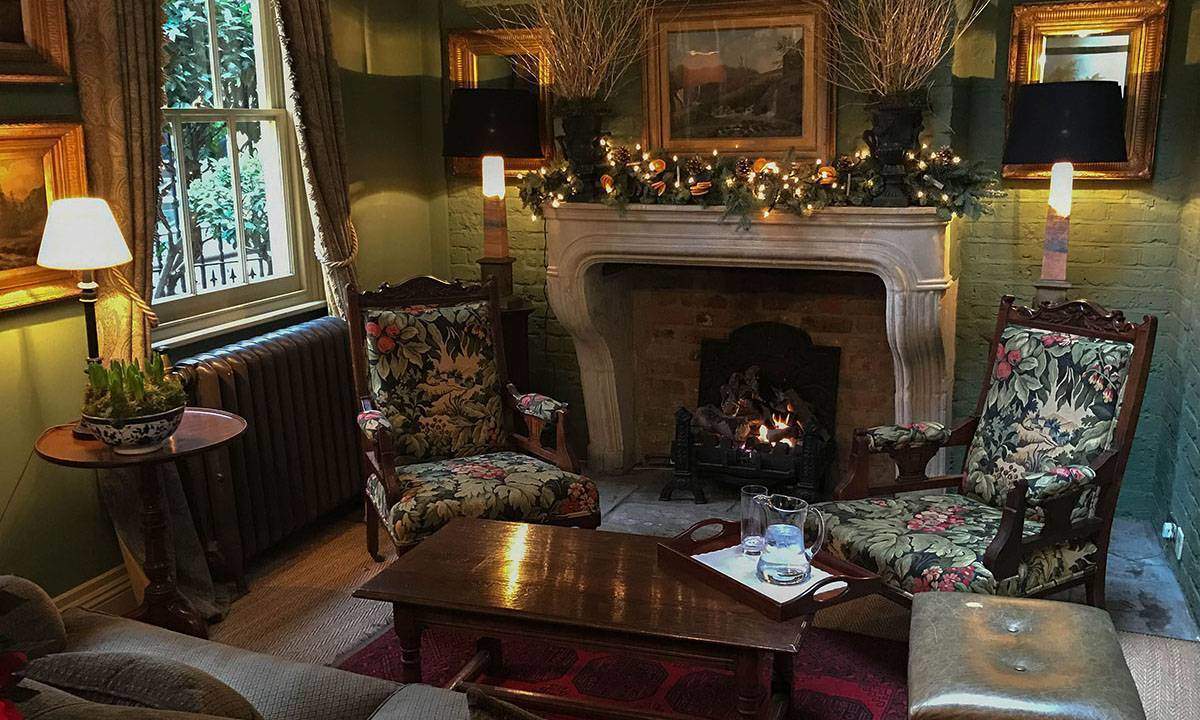In this current era of travel, when the hippest hotels in every city around the world look identical to their counterparts in every other city around the world, I’ve become well-versed in their signifiers, defined collectively by what can only be called an extravagant minimalism. They deal in former manufacturing spaces, or the appearance of them, gussying them up only here and there with statement pieces like chandeliers and velvet sofas, long communal work tables and art that’s winking at itself. The template has infiltrated every corner of the globe.
How refreshing it was, then, to show up to a hotel in London that was so persuasively the embodiment of that city, that aspired only to build on what came before it in the very place it inhabited. Of all the buildings I stepped inside during a recent three-day visit to London, none was more proudly English than the one where I lay my head, The Rookery Hotel in Clerkenwell.
At the Rookery, there were no post- or faux-industrial flourishes, no shellacked concrete floors, no gothic accents, no strategically exposed brick. I was no longer floating in what Kyle Chayka, in a recent essay for The Verge, dubbed AirSpace, “the realm of coffee shops, bars, startup offices, and co-live/work spaces that share the same hallmarks everywhere you go.”
The designers of the Rookery, on the other hand, smartly gave way to the quirks of the 18th century buildings that house it. Even those quirks that most challenge a contemporary sensibility I ultimately forgave, and in most cases came to embrace, as part of a singular experience. There was no elevator to drop me off by my third-floor room, for example, but it turned out I am an able-bodied human for whom navigating stairs comes easily. The public areas are comprised of a series of small, cozy rooms on the ground floor, flush with Georgian design elements, following the original footprint and making no attempt at a more sweeping public area. In one, an “honesty bar” is there for the exploiting 24 hours a day—you make your own drink using the extensive selection of booze and mixers, and then record it in a book on a nearby table so the hotel can charge your bill.
There is no gym. Also, no restaurant. And yet, it turns out that even for the business traveler, the amenities are completely adequate. The wifi worked great, for one thing—for most of us the thing—and there were plenty of spaces to conduct meetings, including a warmly lit conference room with large casement windows overlooking Cowcross Street.
I happened to pull up to the Rookery during a drizzly rain and then found the entrance to the hotel in one of those ancient London lanes, just off Cowcross, too narrow for anything but pedestrians. Around it, the bustle gave the Clerkenwell neighborhood a heartbeat. The famous Smithfield Market, the oldest church in London (St Bartholomew the Great, active since the 12th century), and a plethora of forward-thinking bars and restaurants are within a stone’s throw.
Inside, just behind reception, those old stairs led to the upper floors and 33 guest rooms, each named after a historic Clerkenwell character. Ours, the William Petit Griffiths, was on the third and top floor. The room itself has a ceiling that follows the shape of the roof. Much of the furniture—the desk, armoire, bed and lamps in particular—seem to be legitimate antiques. How nice to be in a hotel room in which one can throw the shutters and then windows open. A dainty tufted chair and round wooden table served as my desk—I could have used something more substantial to work on, but this did the trick, and spending time in this room was so pleasant an experience that I forgave the restricted work space.
In the bathroom, black and white floors got a nice backdrop from the mustard yellow walls. Both framed the showpiece—an impossibly deep claw-foot tub, black on the outside and white on the inside and dramatic all over. I took three baths in two days, such was the joy of submerging in that thing. And to think that when I first arrived I was disappointed to discover there was no shower. Other bathroom notes include toiletries from REN, and the best toilet paper ever—sturdier and softer than any other I’ve known. The exposed copper piping was a nice touch. The sink was the old-fashioned kind with two separate faucets for hot and cold water—it’s one of those quirks mentioned above that I chose to forgive, I mean embrace.
Even without a restaurant on the premises, The Rookery offers up a fantastic breakfast, served either in the common areas downstairs or, for no extra charge, in the room. The lattes were great, as were the freshly baked breads and pastries, and fresh orange juice.
The staff was exactly what I prefer in one—competent but laid back. They never gave the impression of being overeager to please, yet everything necessary got taken care of, always. They carried themselves much like Lady Grey, the hotel cat, who couldn’t be bothered but also was never less than entirely put together. It’s yet another example of how at this hotel, I had the pleasure of recognizing over and over again, at every turn and in every corner, that I was in England.







